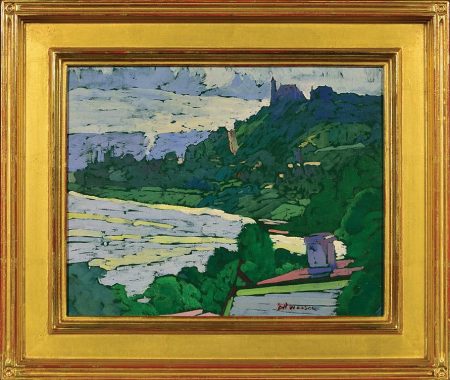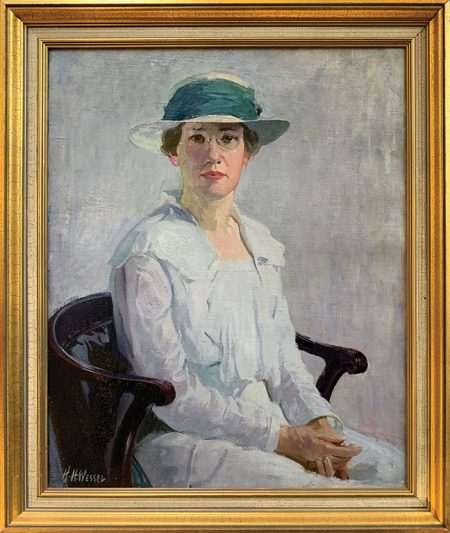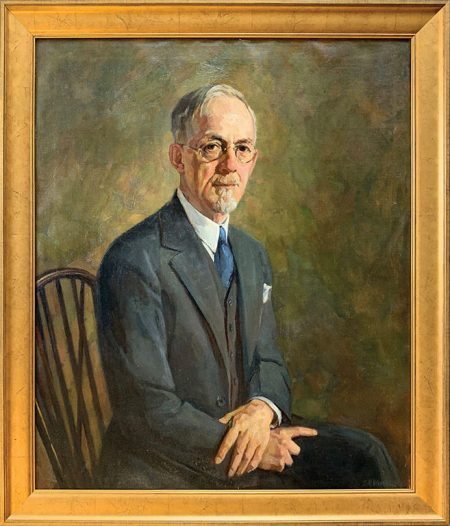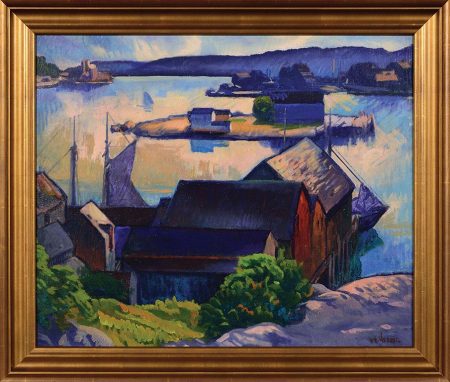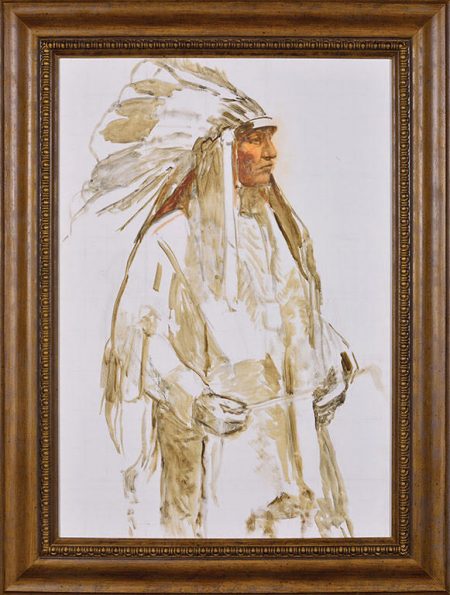“They (Herman and Bessie Wessel) believed that recording the infinitely varied pageantry of the visible world with paint was an exceedingly and challenging pursuit; one that dwelled not on the ebb and flow of any fashionable modernist creed, but rather on the simple and timeless of joy of living.” 1
That is the beginning of the essay by Carol A. Cyran for the 1997 exhibition of Herman and Bessie Wessel works at the Cincinnati Art Club. It’s still the best way to introduce their work in the “Paintings by Bessie and Herman Wessel from the Estate of Helen Wessel” exhibition at Cincinnati Art Galleries.
Herman and Bessie were active participants in what David Hausrath of Cincinnati Art Galleries calls the Golden Age of painting in Cincinnati. Nearly all of the paintings –35 by Bessie and 25 by Herman–come from the collection of Helen Wessel, their daughter-in-law. It is fitting that their work has come home to Cincinnati.
Herman Wessel was born on January 16, 1878, in Vincennes, Indiana. Wanting to study art, Herman sold some inherited property and enrolled in the Cincinnati Art Academy in 1896, studying with Caroline Lord and Frank Duveneck with whom he developed a close and lasting friendship. In 1904, Herman sailed for Europe and spent the next four years there. He studied at the Royal Academy in Munich where Duveneck had studied. In Paris he worked at the Académies Julian and Colarossi.
When Herman returned to Cincinnati in 1908, he began teaching drawing and anatomy and other subjects at his alma mater eventually becoming the dean of painting. After teaching for 39 years, he resigned in 1947 due to poor health.
Herman was an active participant in the city’s art scene. In addition to teaching, he was the artist representative of Cincinnati’s Committee for City planning and also the curator of paintings at the Art Museum for 13 years.
Born on January 7, 1889, in Brookville, Indiana, Bessie Hoover was also a Hoosier. Her schoolteacher father encouraged her art ambitions, and in 1906 she enrolled at the Cincinnati Art Academy. She studied with Lewis Henry Meakin and then Herman Wessel, but their romance began when she joined the Art Academy faculty in 1915. She took classes with Duveneck from 1909 to 1915. Like her future husband, Duveneck became a life long friend.
Shortly after their marriage, Herman painted a youthful Bessie. Dressed in a white, somewhat gauzy summery white dress that is not crisply starched or terribly wrinkled, she sits upright in a chair but slumps almost imperceptibly as if the air has gone out of her body. Her hands are lightly clasped in her lap, and she turns to fix her gaze on Herman. The chair’s back and arms wrap around her as if embracing her, but she does not lean back. She is quietly asserting her power. You just know she’ll pursue her career in a professional fashion.
Bessie painted her husband when he was in his 60s. His pose is nearly identical to the one he used in his wife’s portrait. Sitting upright in a Shaker-like chair, he wears a dapper blue/gray suit with vest and pocket square. His left hand lies lightly on his right wrist while that hand rests on his thigh with four fingers curled under his hand; his forefinger points to something beyond the painting. With his slender frame and debonair goatee, he could be a courtly Spanish grandee. Like Portrait of Bessie, he gazes directly at the viewer with an expression of intelligence and confidence.
Bessie had a less public career than her husband, especially in the early years. Both exhibited widely, although Herman showed in what were more prestigious shows. For example, Herman was in the 1936 Municipal Art Show in New York, an international exhibition of American painting and sculpture. During the same time frame, Bessie showed at the 1933 Women’s National Exposition at Cincinnati’s Music Hall.
From 1915 to 1917, Bessie taught at the Art Academy, quitting because she became too involved in her students’ work, to the detriment of her own. She continued to be a part of the city’s art community, serving as president of the Women’s Art Club, the female counterpart to the Cincinnati Art Club, from 1917 to 1919.
When their son, Robert, was born in 1921, Bessie chose to stay home. Her daughter-in-law, Helen, described her as “a good cook and creative party giver.” 2
The Wessels had a special bond with Duveneck. In August 1917, they were married in his cottage in Gloucester. After his untimely death in 1919 the Wessels became prime authenticators of Duveneck’s work. The vase in this painting was a gift from the Wessels’ friend and mentor.
In a November 15, 1996, phone call, Helen Wessel told Cyran and her artist husband, Carl Samson, that Bessie would “paint with Duveneck’s brushes at times of artistic struggle in order to receive inspiration.” 3
In 1929, with proceeds from Herman’s local mural commissions, 4 the Wessels built a one-and-half story studio near Eden Park in 1929. They were also able to take a 15-month sabbatical in Europe accompanied by their eight-year-old son. They visited Munich; Venice, Florence, and Rome in Italy among other stops and spent eight months in Paris.
In the 1930s, the Art Academy placed new emphasis on creative and more avant-garde expression. This led Herman to experiment in paintings such as Five Pound Island from around 1933. Cyran noted he had simplified “geometric planes of rich color with bold outline.” 5 To my eye, there is a closer relationship to Cézanne than Rouault in Herman’s blocky forms and planes of solid color that make up the structures on the shore and the sea and landscape elements.
Cyran opines that occasionally Herman was inspired to push boundaries with “a new style or fresh mode of expression,” simultaneously setting the “outer limits beyond which he dare not tread.” 6
In Herman’s later years, Cyran observed that he had “tired of his prior experimental phase, returning for the most part to painting and drawing in a more naturalistic-impressionist tradition.” 7
Herman’s Winter Along the Ohio, painted two years before his death, illustrates that. Again referencing Cézanne, he has used a compositional structure of planes of color to define the blocky shack, the tugboat pushing barges upriver, the piers of the Roebling Bridge, even the body of the man, burdened with a backpack and using a cane, making his way to shelter. Herman masterfully differentiates the appearance of the white snow lying on the riverbank from the choppy waters of the Ohio, kicking up whitecaps. Herman displayed the same facility of working with white in his Portrait of Bessie.
Bessie was as skilled with the brush as her husband and developed a distinctive and idiosyncratic style that critics called “mosaic” for the way she used daubs of paint as if they were mosaic tiles to build up the composition.
For these mosaic paintings, Bessie started by making a preliminary drawing in white chalk on her preferred support–green linen window shades, which were easy to transport and readily available. She laid down distinct single strokes of paint, followed by larger planes of light. Some parts of the canvas were left uncovered to outline forms. She reduced everything to its most essential.
Cyran wrote in the Cincinnati Art Club catalogue, “The end result was a scintillating symphony of color, shape, texture, and form.” Cyran quotes a 1931 review that exclaimed, “(H)ere is the very essence of color–color that is studded like jewels in all sorts of shapes that make veritable color chords.” The writer of a 1933 critique praised how Bessie’s application of “colors by their juxtaposition scintillate and glisten like burnished jewels.’’ 8
In the 1940s there were shifts in the Wessels’ daily lives. In 1947 Herman retired from the Art Academy due to ill health. In retirement he focused on more personal work in etchings, monotypes, and paintings, returning to a more naturalist approach. As he became less mobile, he used sketches and photographs made on earlier trips. 9 He continued painting until two years before his death at 91 in 1969.
After Robert grew up, Bessie had more time to work. She painted still lifes, landscapes, and portraits that would eventually become a thriving business into the 1960s. She had her first one-person show of portraits at Cincinnati’s Loring-Andrews Gallery in 1949. Sought after as a portraitist (she painted 200 portraits), she had a particular ability to capture the vitality of children.
Bessie painted her future daughter in law, Helen, before she married her son in 1952. She presents the visage of a lovely young woman, looking unselfconsciously at the viewer with an oddly penetrating look and slight Mona Lisa smile. The green background, which is worked in the mosaic style, suggests lush vegetation. With Helen’s off-the-shoulder dress in tangerine, Bessie has put her in a tropical paradise.
After Herman died in 1969, Bessie started her final series of portraits. At some point, she had acquired a collection of 40 glass negatives of Native Americans who had camped in Cincinnati in 1896. Their noble demeanor inspired her.
Bessie was afraid that this series–“Portraits from the Plains”–would not sell well at the upcoming gallery exhibition but within a week it was practically sold out. 10
Bessie left one unfinished Native American canvas: White Feathered Headdress. In white chalk, she roughed out his body and what promised to be a spectacular headdress, but fleshed out his face, catching his fierce and determined expression.
After this show, which was mounted in the early 1970s, Bessie made a few more paintings, mainly florals and still lifes, but also did one final portrait commission. She died in 1973.
The strength of this exhibition is how it captures the spirit of Cincinnati’s art scene in the first half of the 20thcentury. The Wessels traveled and brought home what they had seen and experienced, but there is no evidence that either ached to leave Cincinnati for more a cosmopolitan art center such as New York or Paris where they did live for eight months in 1929. They were comfortable in Cincinnati and the city nurtured them; they helped create the city’s Golden Age of painting.
–Karen S. Chambers
END NOTES
1 Cyran, Carol A., “Herman and Bessie Wessel, At Home and Abroad,” Herman and Bessie Wessel At Home and Abroad, Cincinnati, Cincinnati Art Club, 1997, p. 8.
2 Helen Wessel, handwritten biography of Bessie Wessel.
3 Op.cit. Herman and Bessie Wessel At Home and Abroad.
4 Herman completed a number of mural commissions in the Cincinnati area. Locations included the Belvedere apartments, Federal Reserve Building, Salem Presbyterian Church, Holmes Hospital solarium Ohio State building in Columbus, post office in Springfield, and Mariemont Theater.
5 Op. cit. Herman and Bessie Wessel At Home and Abroad, p. 7.
6 Ibid., pp. 26-27.
7 Ibid., p. 27.
8 Cyran, Carol, “The Golden Legacy of Herman and Bessie Wessel,” Paintings by Bessie and Herman Wessel from the Estate of Helen Wessel, Cincinnati, Cincinnati Art Galleries, 2019, pp. 5-6
9 Op. cit., Herman and Bessie Wessel At Home and Abroad, pp. 8-9.
10 Op. cit., Paintings by Bessie and Herman Wessel from the Estate of Helen Wessel, p. 10.
“Paintings by Bessie and Herman Wessel from the Estate of Helen Wessel,” through November 23, 2019. Cincinnati Art Galleries, 225 E. 6th Street, Cincinnati, OH 45202, 513-381-2128, www.cincyart.com, art@cincyart.com. Hours: Monday – Friday: 9am – 4pm; Saturdays: 10am – 4pm. Parking: Cincinnati Art Galleries has 3 reserved parking spots located on the side of our building. Feel free to park in any of those reserved spots when available. Parking is free behind the gallery on Saturdays.


